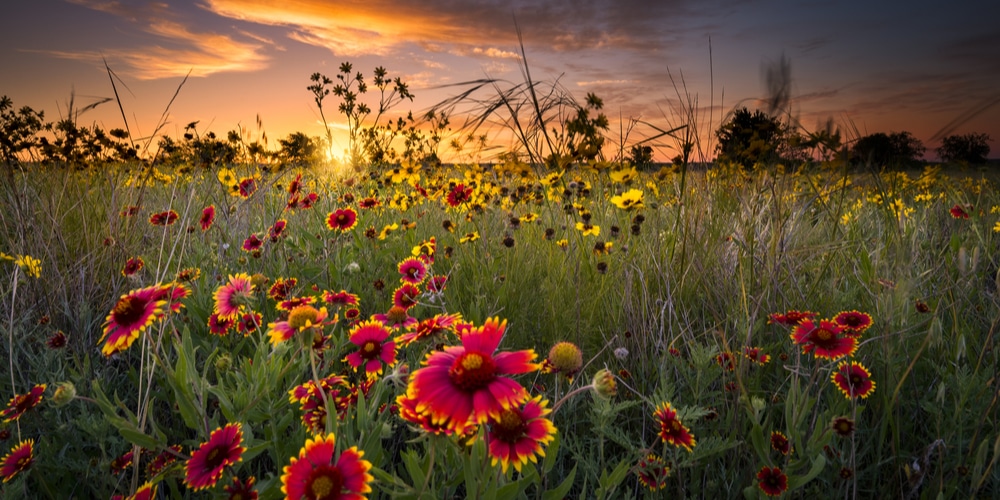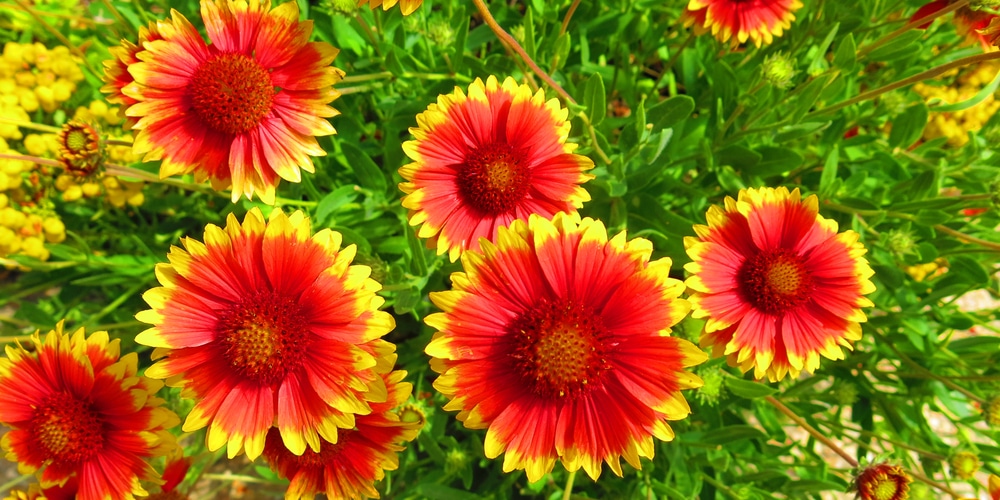Also known as blanket flower, Gaillardia is an easy-to-grow, richly colored, short-lived perennial flower. The plant forms a gradually spreading mound and was given the name “blanket flower” because of the way it slowly spread and “blanket” an area. This plant can grow to about 24 inches in height and about a 20-inch spread. If you’re interested in flowers that start with g check out the Gallardia!
Blanket Flower Quick Facts: (Gallardia)
The table below has basic information about the blanket flower to introduce you to this plant care:
- Botanical Name: Gaillardia x Grandiflora
- Common Names: Blanket flower, Gallardia
- Family: Asteraceae
- Mature Size: 24 – 36 in. tall; 12- to 24-in. spread
- Plant Type: Herbaceous perennial
- Exposure to Sunlight: Requires bright, direct sunlight
- Soil pH: 6.1 to 6.5 (slightly acidic)
- Soil Type: Poor, well-draining soil
- Toxicity: Slightly toxic to humans
- Bloom Time: Repeat bloomer, summer through fall
- Hardiness Zones: 3-10 (USDA); varies by variety
- Flower Color: Different shades of red, orange, yellow, or peach
- Native Area: Cultivated hybrid; parents are wildflowers native to North American
How to Grow & Care for Blanket Flower (Gallardia)
Here are tips on how to care for the blanket flower properly:
Light Requirement
The blanket flower thrives best in full sun. The plant can tolerate partial shade, but the color of the foliage will be less vibrant than it would in full sun.
Watering
The blanket flower is a drought-tolerant plant and can tolerate periods of light with moderate watering. The plant does best when the soil is kept evenly moist but not soaking wet. Over-watering can lead to rot on the foliage, especially if the soil becomes overly soggy.
Pruning
The blanket flower is an evergreen perennial, so it will not die back in the winter. You can prune the plant to keep it tidy and healthy. Simply remove dead leaves and branches to maintain a neat appearance in your garden.
Soil
Blanket flower prefers poor soil. Therefore, you should avoid using rich matter or over-fertilizing the plant. Also, the soil should be well-drained, and it should be kept a little moist. The blanket flower may wither and dry off if the soil becomes overly dry.
Fertilizer
The blanket flower needs very little fertilizer to thrive. A slow-release fertilizer with a balanced formula that includes essential elements such as nitrogen, phosphorus,, and potassium will work well for this plant.
Temperature and Humidity
Blanket flowers thrive in full sun. They can tolerate high temperatures between 15 and 30 degrees F. Keeping the humidity level in check can also make a difference in how well the blanket flower does in your garden. This plant does not require a humid environment and thrives in a hot, dry climate. In cooler climates, you need to protect your blanket flowers with a layer of mulch.
Pest Control
Blanket flowers can be susceptible to pests such as aphids, mealybugs, and spider mites. These pests can be controlled by using insecticidal soap or horticultural oil regularly.
Mulching Blanket Flower
You can protect your blanket flower from direct sunlight by adding a layer of mulch. Mulch will reduce evaporation from plants, which will help protect the plant from getting sunburned. You can use a layer of dry grass, leaves, or compost to create this mulch.
Propagation
In order to propagate the blanket flower, cut the stems and place the piece in a jar of water. After the cut piece has been rooted, try to remove it from the water and put it in a pot filled with soil. The plant grows best in full sun and can be grown in containers.
The blanket flower is an easy-to-grow, colorful perennial that thrives when planted in well-drained soil. The plants form a slowly spreading mound, so they are best suited for locations that don’t have too much interference. The plant is drought tolerant, so you don’t have to worry about your plant not receiving a daily dose of H2O. If you live in a warm climate, consider planting this plant outdoors to get some colorful vegetation when other plants are dormant during the winter months.
Flowers that start with g: The Takeaway
The blanket flower is an easy-to-grow perennial and will thrive in a sunny area. The plants grow slowly, and their foliage turns a brilliant shade of bright yellow in the spring. The plant will not tolerate temperatures below 50 degrees Fahrenheit, so it should not be planted in winter or extremely cold areas.
You may also be interested in: Landscape Gardening

